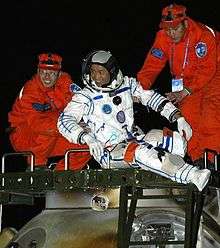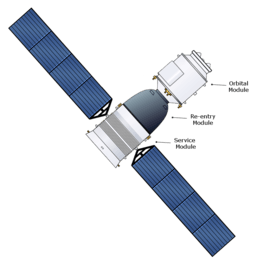Shenzhou program
| Shenzhou program | |||||||
 Nie Haisheng exits the re-entry capsule of Shenzhou 6 at the main landing field in Central Inner Mongolia. | |||||||
| Chinese | 神舟 | ||||||
|---|---|---|---|---|---|---|---|
| Hanyu Pinyin | Shénzhōu | ||||||
| |||||||
The Shenzhou program (/ˈʃɛnˈdʒoʊ/,[1] Chinese: 神舟) is a manned spaceflight initiative by China. The program put the first Chinese citizen, Yang Liwei, into orbit on 15 October 2003.
Development began in 1992, under the name of Project 921-1. The Chinese National Manned Space Program was given the designation Project 921 with Project 921-1 as its first significant goal. The plan called for a manned launch in October 1999, prior to the new millennium.
The first four unmanned test flights happened in 1999, 2001 and 2002. These were followed with another manned launch on 12 October 2005. It is launched on the Long March 2F from the Jiuquan Satellite Launch Center. The command center of the mission is the Beijing Aerospace Command and Control Center. The China Manned Space Engineering Office provides engineering and administrative support for the manned Shenzhou missions.[2]
The name is variously translated as "Divine Ark", "Divine Vessel" or similar, but is also a reference to a literary name for China with the same pronunciation (神州; literally "Divine Land").
History
China's first efforts at human spaceflight started in 1968 with a projected launch date of 1973. Although China did launch an unmanned satellite in 1970 and has maintained an active unmanned program since, the manned spaceflight program was cancelled due to lack of funds and political interest.
The current Chinese human spaceflight program was authorized on 1 April 1992 as Project 921-1, with work beginning on 1 January 1993. The initial plan has three phases:
- Phase 1 would involve launch of two unmanned versions of the manned spacecraft, followed by the first Chinese manned spaceflight, by 2002.
- Phase 2 would run through 2007, and involve a series of flights to prove the technology, conduct rendezvous and docking operations in orbit, and operate an eight-ton spacelab using the basic spacecraft technology.
- Phase 3 would involve orbiting of a 20-ton space station in the 2010–2015 period, with crews being shuttled to it using the eight-ton manned spacecraft.
In 1994, Russia sold some of its advanced aviation and space technology to the Chinese government. In 1995 a deal was signed between the two countries for the transfer of Russian Soyuz spacecraft technology to China. Included in the agreement was training, provision of Soyuz capsules, life support systems, docking systems, and space suits. In 1996 two Chinese astronauts, Wu Jie and Li Qinglong, began training at the Yuri Gagarin Cosmonaut Training Center in Russia. After training, these men returned to China and proceeded to train other Chinese astronauts at sites near Beijing and Jiuquan. The hardware and information sold by the Russians led to modifications of the original Phase One spacecraft, eventually called Shenzhou, which loosely translated means “divine vessel.” New launch facilities were built at the Jiuquan launch site in Inner Mongolia, and in early 1998 a mock-up of the Long March 2F launch vehicle with Shenzhou spacecraft was rolled out for integration and facility tests.[3]
The chief designers include Qi Faren and Wang Yongzhi. The first unmanned flight of the spacecraft was launched on 19 November 1999 after which Project 921-1 was renamed Shenzhou, a name reportedly chosen by Jiang Zemin. A series of three additional unmanned flights ensued. The Shenzhou reentry capsules used to date are 13 percent larger than Soyuz reentry capsules, and it is expected that later craft will be designed to carry a crew of four instead of Soyuz's three, although physical limitations on astronaut size, as experienced with earlier incarnations of Soyuz, will likely apply.
The fifth launch, Shenzhou 5, was the first to carry a human (Yáng Lìwěi) and occurred at 9:00 CST (UTC +8) on 15 October 2003.
Like similar space programs in other nations, Shenzhou has raised some questions about whether China should spend money on launching people into space, arguing that these resources would be better directed elsewhere. Indeed, two earlier human spaceflight programs, one in the mid-1970s and the other in the 1980s were cancelled because of expense. In response, several justifications have been offered in the Chinese media. One is that the long-term destiny of humanity lies in the exploration of space, and that China should not be left behind. Another is that such a program will catalyze the development of science and technology in China. Finally, it has been argued that the prestige resulting from this capability will increase China's stature in the world, in a similar manner to the 2008 Olympics.
On 17 October 2005, following the success of Shenzhou 6, Chinese media officially stated that the cost of this flight was around $110 million USD, and the gross cost of Project 921/1 in the past 11 years was $2.3 billion USD. These values are lower than the cost of similar space programs in other nations.
The Chinese media has heavily promoted the experiments undertaken by Shenzhou, particularly exposing seeds, including some from Taiwan, to zero gravity and radiation. Most scientists, however, discount the usefulness of this type of experiment.
The experience during the 1960s of both the United States with the Manned Orbiting Laboratory and the Soviet Union with the Almaz space station suggests that the military usefulness of human spaceflight is quite limited and that practically all military uses of space are much more effectively performed by unmanned satellites. Thus while the Shenzhou orbital module could be used for military reconnaissance there appears to be no military reason for incorporating such a system in a manned mission, as China could use purely unmanned satellites for these purposes.
Shenzhou spacecraft

The Shenzhou spacecraft resembles the Russian Soyuz, although it is substantially larger, and unlike the Soyuz, it features a powered orbital module capable of autonomous flight.
Like Soyuz, Shenzhou consists of three modules: a forward orbital module (轨道舱), a reentry capsule (返回舱) in the middle, and an aft service module (推进舱). This division is based on the principle of minimizing the amount of material to be returned to Earth. Anything placed in the orbital or service modules does not require heat shielding, and this greatly increases the space available in the spacecraft without increasing weight as much as it would if those modules were also able to withstand reentry.
Missions launched
Unmanned missions
| Mission | Launch | Duration | Landing | Notes |
|---|---|---|---|---|
| Shenzhou 1 | 19 November 1999 | 0 d 21 h 11 m | 20 November 1999 | Unmanned test flight |
| Shenzhou 2 | 9 January 2001 | 7 d 10 h 22 m | 16 January 2001 | Carried scientific payload including monkey, dog, rabbit and other animals. |
| Shenzhou 3 | 25 March 2002 | 6 d 18 h 51 m | 1 April 2002 | Carried a test dummy. |
| Shenzhou 4 | 29 December 2002 | 6 d 18 h 36 m | 5 January 2003 | Carried a test dummy and several science experiments. |
| Shenzhou 8 | 31 October 2011 | 16 d 13 h 34 m | 17 November 2011 | Unmanned mission, rendezvoused and docked with Tiangong-1. |
Crewed missions
| Order | Patch | Mission | Launch | Duration | Landing | Crew | Notes | |||||
|---|---|---|---|---|---|---|---|---|---|---|---|---|
| 1 | | Shenzhou 5 | 15 October 2003 | 0 d 21 h 22 m 45 s | 15 October 2003 | Yang Liwei | First Chinese manned flight, 14 Earth orbits. | |||||
| 2 | | Shenzhou 6 | 12 October 2005 | 4 d 19 h 33 m | 16 October 2005 | Fei Junlong | Nie Haisheng | Multiple days in space, 75 orbits. | ||||
| 3 | | Shenzhou 7 | 25 September 2008 | 2 d 20 h 27 m | 28 September 2008 | Zhai Zhigang | Liu Boming | Jing Haipeng | First three-person crew, first Chinese spacewalk. | |||
| 4 | | Shenzhou 9 | 16 June 2012 | 12 d 15 h 24 m | 29 June 2012 | Jing Haipeng | Liu Wang | Liu Yang | First Chinese woman in space; first docking with Tiangong-1 space station, 18 June 2012, 06:07 UTC.[4] | |||
| 5 | | Shenzhou 10 | 11 June 2013 | 15 d | 26 June 2013 | Nie Haisheng | Zhang Xiaoguang | Wang Yaping | Second Chinese woman in space; second docking with Tiangong-1 space station. | |||
Future missions
| Mission | Date | Launcher | Launch Site | Notes |
|---|---|---|---|---|
| Shenzhou 11 | end of 2016 | CZ-2F | JQSLC | Manned to Tiangong 2 |
| Shenzhou 12 | 2018 | CZ-2F | JQSLC | Manned to Tiangong 2[5] |
| Shenzhou 13 | 2019 | CZ-2F | JQSLC | Manned to Space Station Core Module |
| Shenzhou 14 | 2020 | CZ-2F | JQSLC | Manned to Space Station Core Module |
| Shenzhou 15 | 2021 | CZ-2F | JQSLC | Manned to Space Station |
| Shenzhou 16 | 2022 | CZ-2F | JQSLC | Manned to Space Station |
Astronauts
November 1996 trainer selection
There were two astronaut trainers selected for Project 921. They trained at the Yuri Gagarin Cosmonauts Training Center in Russia.
- Li Qinglong – born August 1962 in Dingyuan, Anhui Province and PLAAF interceptor pilot and space instructor at Star City
- Wu Jie
January 1998 Shenzhou astronaut candidate selection
- Chen Quan
- Deng Qingming – from Jiangxi Province and PLAAF pilot;
- Fei Junlong – second Chinese astronaut, commander of Shenzhou 6
- Jing Haipeng – born October 1966 and PLAAF pilot, astronaut of Shenzhou 7 and Shenzhou 9
- Liu Boming – born September 1966 and PLAAF pilot, astronaut of Shenzhou 7
- Liu Wang – born in Shanxi Province and PLAFF pilot, flew on Shenzhou 9
- Nie Haisheng – back up in Shenzhou 5, flight engineer on Shenzhou 6, commander of Shenzhou 10
- Pan Zhanchun- PLAAF pilot
- Yang Liwei – first man sent into space by the space program of China on Shenzhou 5, made the PRC the third country to independently send people into space
- Zhai Zhigang – back up in Shenzhou 5, commander of Shenzhou 7
- Zhang Xiaoguang – born in Liaoning Province and PLAAF pilot, flew on Shenzhou 10
- Zhao Chuandong – PLAAF pilot
In July 2007, plans were announced to select up to 14 men for another group of Shenzhou astronaut candidates.[6]
See also
- Long March rocket
- Tiangong
- Space program of China
- China National Space Administration
- Beijing University of Aeronautics and Astronautics
References
| Wikimedia Commons has media related to Shenzhou. |
- Specific
- ↑ "Shenzhou pronunciation". Dictionary.com. Retrieved 25 April 2015.
- ↑ "China's Manned Space Program Takes the Stage at 26th National Space Symposium". The Space Foundation. April 10, 2010.
- ↑ Futron Corp. (2003). "China and the Second Space Age" (PDF). Futron Corporation. Retrieved October 6, 2011.
- ↑ Jonathan Amos (18 June 2012). "Shenzhou-9 docks with Tiangong-1". BBC. Retrieved 21 June 2012.
- ↑ http://orbiter-forum.com/showthread.php?t=23181&page=19
- ↑ "China prepares to select new taikonauts". People's Daily Online. July 18, 2007. Retrieved August 1, 2007.
- General
- "Shenzhou". Retrieved 21 July 2005.
- "China's first astronaut revealed". BBC. 7 March 2003.
- "Brief history of Russian aid to Chinese space program". Archived from the original on 8 April 2007. Retrieved 7 June 2007.
- "Details on purchase of Soyuz descent capsule by China, Space.com". Retrieved 7 June 2007.
External links
- Flickr: Photos tagged with shenzhou, photos likely relating to Shenzhou spacecraft
| ||||||||||||||||||||||||||||||||||||||
| |||||||||||||||||||||||||||||||||||||||||||||||||||
| ||||||||||||||||||||||||||||||||||||||||||||||||||||||||||||||||
